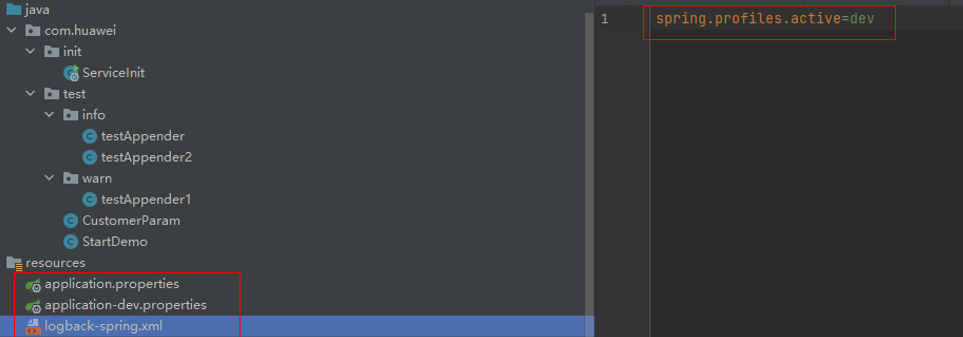云日志服务LogBack SDK
云日志服务Java SDK提供了与logback适配的扩展插件,可以直接在logback中配置华为云appender,将通过logback产生的日志直接上报至云日志服务。
传输协议
HTTPS
使用前提
- 参考注册华为账号并开通华为云中操作,完成注册。
- 确认云日志服务的区域,请用户根据所在区域,选择RegionName。
- 获取华为账号的AK/SK。
- 获取华为云账号的项目ID(project id),详细步骤请参见API凭证。
- 获取需要上报到LTS的日志组ID和日志流ID。
- 已安装Java开发环境。云日志服务Java SDK支持JDK1.8及以上,您可以执行java –version命令检查您已安装的Java版本。如未安装,可以从Java官方网站下载安装包进行安装。
- SDK支持跨云/本地上报日志,当前仅支持华北-北京四、华东-上海一、华南-广州、西南-贵阳一。
- 支持将logback.xml变为logback-spring.xml(SpringBoot),且读取springProfile中的配置。
- 支持读取logback.xml、logback-spring.xml中的自定义标签。
- 通过LogBack SDK上报日志到LTS的时间相距当前时间不超过2天,否则上报日志会被LTS删除。
- 建议设置上报周期小于1分钟(例如50秒)上报一次,设置1分钟或超过1分钟上报一次,可能会出现连接失败,因为SDK连接默认1分钟超时。
安装SDK
在Maven项目中加入依赖项。
- 使用Maven构建项目时,settings.xml文件的mirrors节点需要增加华为外部开源仓。如下:
<mirror> <id>huaweicloud</id> <mirrorOf>*</mirrorOf> <url>https://repo.huaweicloud.com/repository/maven/</url> </mirror> - 您可以在华为外部开源仓中获取云日志服务LogBack SDK依赖的最新版本。
- 在Maven工程中使用云日志服务LogBack SDK,只需在pom.xml中加入相应依赖即可,Maven项目管理工具会自动下载相关JAR包。在<dependencies>中加入如下内容:
推荐使用最新版本version:1.1.3,第2步中查看SDK版本。
<dependency> <groupId>io.github.huaweicloud</groupId> <artifactId>lts-sdk-common</artifactId> <version>version</version> <exclusions> <exclusion> <groupId>org.slf4j</groupId> <artifactId>slf4j-simple</artifactId> </exclusion> </exclusions> </dependency> <dependency> <groupId>io.github.huaweicloud</groupId> <artifactId>lts-sdk-logback</artifactId> <version>version</version> </dependency>
示例代码
- 编写logback.xml、logback-spring.xml中LogbackSDKAppender,示例如下:
<configuration scan="true" debug="false"> <appender name="LogInfoTest" class="com.huaweicloud.lts.appender.LogbackSDKAppender"> <!-- 华为云账号的项目ID(project id) --> <projectId>xxxxxxxxxxxxxxxxxxxxxx</projectId> <!-- 华为云日志服务日志组ID --> <logGroupId>xxxxxxxxxxxxxxxxxxxxxx</logGroupId> <!-- 华为云日志服务日志流ID --> <logStreamId>xxxxxxxxxxxxxxxxxxxxxx</logStreamId> <!-- 华为云账号的AK, 认证用的AK硬编码到代码中或者明文存储都有很大的安全风险, 建议密文存放, 使用时解密, 确保安全 --> <accessKeyId>xxxxxxxxxxxxxxxxxxxxxx</accessKeyId> <!-- 华为云账号的SK, 认证用的SK硬编码到代码中或者明文存储都有很大的安全风险, 建议密文存放, 使用时解密, 确保安全 --> <accessKeySecret>xxxxxxxxxxxxxxxxxxxxxx</accessKeySecret> <!-- 云日志服务的区域 --> <regionName>cn-nxxxxx</regionName> <encoder> <pattern>%d %-5level [%thread] [%customerParam] %logger{0}: %msg</pattern> </encoder> <!-- 单个Appender能缓存的日志大小上限 --> <totalSizeInBytes>104857600</totalSizeInBytes> <!-- producer发送日志时阻塞时间 --> <maxBlockMs>0</maxBlockMs> <!-- 执行日志发送任务的线程池大小 --> <ioThreadCount>8</ioThreadCount> <!-- producer发送单批日志量上限 --> <batchSizeThresholdInBytes>524288</batchSizeThresholdInBytes> <!-- producer发送单批日志条数上限 --> <batchCountThreshold>4096</batchCountThreshold> <!-- producer发送单批日志等待时间 --> <lingerMs>2000</lingerMs> <!-- producer发送日志失败后重试次数 --> <retries>5</retries> <!-- 首次重试的退避时间 --> <baseRetryBackoffMs>500</baseRetryBackoffMs> <!-- 重试的最大退避时间 --> <maxRetryBackoffMs>500</maxRetryBackoffMs> <!-- 默认false, true: 可以跨云上报日志, false: 仅能在华为云ecs主机上报日志 --> <enableLocalTest>false</enableLocalTest> <!-- 超过1M的日志, 拆分后放弃1M以外的 --> <!-- <giveUpExtraLongSingleLog>true</giveUpExtraLongSingleLog>--> <!-- 是否使用日志组/日志流名称上报日志--> <!-- <logGroupStreamByName>false</logGroupStreamByName>--> </appender> <logger name="com.huawei.test.logback.info" level="INFO"> <appender-ref ref="LogInfoTest"/> </logger> </configuration> - 编写代码中产生日志,示例如下:
package com.huawei.test.logback.info; import org.slf4j.Logger; import org.slf4j.LoggerFactory; public class TestLogBackAppenderInfo { private static final Logger LOGGER = LoggerFactory.getLogger(TestLogBackAppenderInfo.class); public void run() throws InterruptedException { LOGGER.info("test~logback~~~info"); } }
producer性能基线
上报日志时,请参考如下参数的测试性能基线,若超出基线值,可能会导致日志上报异常。
ECS虚拟机配置:
- 实例规格:通用计算增强型 c7.xlarge.2
- CPU:4 vCPU
- 内存:8 GB
- 基准带宽:100 Mbit/s
- OS:Huawei Cloud EulerOS release 2.0
- JVM:OpenJDK 64-Bit Server VM (build 17.0.7+7, mixed mode)
测试程序说明(单个producer):
- totalSizeInBytes: 104857600
- maxBlockMs:0
- batchSizeThresholdInBytes: 1048576
- batchCountThreshold:40960
- lingerMs:2000
- ioThreadCount:具体用例中调整
- JVM 初始堆/最大堆大小:1GB
- 发送日志总条数:100,000,000
- 发送日志总大小:约50GB
按照参数基线值设置后,使用华为云ECS机器作为日志上报环境,通过华为云内网服务入口进行上报。
SDK上报性能基线测试结果参考:
- 上报日志:测试中使用的单条日志大小约为550字节。为了模拟数据的随机性,测试使用的数据为随机字符串。
- 性能基线如下:
表1 性能基线 IO 线程数量
数据吞吐量
数据吞吐速率
CPU 使用率
2
8.4MB/S
1.7W条/s
15%
4
15.3MB/S
3W条/s
29%
6
21.5MB/S
4.2W条/s
36%
总结如下:
- CPU时间主要花费在对象的序列化和压缩上,在吞吐量较高的情况下CPU使用率比较高。但在日常环境中,单机数据流量均值为100KB/S,因此造成的CPU消耗几乎可以忽略不计。
- 增加IO线程数量可以显著提高吞吐量,尤其是当IO线程数量少于可用处理器个数时。
- 调整totalSizeInBytes对吞吐量影响不够显著,增加totalSizeInBytes会造成更多的CPU消耗,建议使用默认值。
- 当日志上报量超过单个producer时:
- 建议拆分日志流,使用多个producer上报日志,分摊流量,以保障SDK处于正常上报状态。
- 如果maxBlockMs为0时,SDK处于非阻塞状态,会触发保护机制自动降级,可能会对部分日志做丢弃处理。
- 如果maxBlockMs大于0时,SDK处于阻塞状态,阻塞时间为maxBlockMs,可能会造成SDK发送日志处于阻塞状态。
配置参数说明
- Appender配置参数说明。
表2 Appender配置参数说明表 参数名称
描述
类型
是否需要填写
默认值
projectId
华为云账号的项目ID(project id)。
String
必填
-
accessKeyId
华为云账号的AK。认证用的AK硬编码到代码中或者明文存储都有很大的安全风险,建议密文存放,使用时解密,确保安全。
String
必填
-
accessKeySecret
华为云账号的SK。认证用的SK硬编码到代码中或者明文存储都有很大的安全风险,建议密文存放,使用时解密,确保安全。
String
必填
-
regionName
云日志服务的区域。
String
必填
-
logGroupId
LTS的日志组ID。
String
必填
-
logStreamId
LTS的日志流ID。
String
必填
-
appName
日志标签appName字段。
String
选填
-
pathFile
日志标签pathFile字段。
String
选填
-
totalSizeInBytes
单个producer实例能缓存的日志大小上限。
int
选填
104857600(即100MB)
maxBlockMs
如果producer可用空间不足,调用者在send方法上的最大阻塞时间,单位为毫秒。默认60000毫秒,建议0毫秒。
- 当maxBlockMs值>=0时,则阻塞到设置的时间,如果到达阻塞时间,还是不能获取到内存,即报错且丢弃日志。
- 当maxBlockMs值=-1时,则一直阻塞到发送成功,且不会丢弃日志。
long
选填
60000毫秒
ioThreadCount
执行日志发送任务的线程池大小。
int
选填
客户机器空闲CPU数量,但一定大于1
batchSizeThresholdInBytes
当一个ProducerBatch中缓存的日志大小大于等于batchSizeThresholdInBytes 时,该ProducerBatch缓存的日志将被发送到LTS。
int
选填
524288(即0.5MB)
batchCountThreshold
当一个ProducerBatch中缓存的日志条数大于等于batchCountThreshold时,该ProducerBatch缓存的日志将被发送到LTS。
int
选填
4096
lingerMs
一个ProducerBatch从创建到可发送的逗留时间。
int
选填
2s
retries
如果某个ProducerBatch首次发送失败,能够对其重试的次数,建议为5次。如果retries小于等于0,该ProducerBatch首次发送失败后将直接进入失败队列。
int
选填
10
baseRetryBackoffMs
首次重试的退避时间。
long
选填
0.1s
maxRetryBackoffMs
重试的最大退避时间。
long
选填
50s
giveUpExtraLongSingleLog
超过1M的日志,拆分后丢弃大于1M的数据。
boolean
选填
false
enableLocalTest
是否开启跨云上报日志。(此功能仅适用于开发调测,对于上报性能不做保障)
- 选true时,开启跨云后用户能通过公网(仅支持华北-北京四、华东-上海一、华南-广州、西南-贵阳一)访问。
- 选false时,关闭跨云后用户是通过华为云当前区域主机访问。
boolean
选填
false
logGroupStreamByName
是否使用日志组/日志流名称上报日志(SDK版本最低必须为1.1.0支持此功能)。如果为true,表明使用名称上报,则logGroupId、logStreamId参数值分别填入日志组、日志流名称即可。
boolean
选填
false
proxyIp
使用自定义ip端口上报日志。
String
选填
-
- 如果是SpringBoot项目,则可以将logback.xml替换为logback-spring.xml,且支持读取springProfile中的配置,可以自由切换开发、测试等环境的日志采集环境。
- 如果需要logback.xml、logback-spring.xml支持自定义标签,且将标签中的value打印到日志中。执行以下步骤:
- 需要继承ClassicConverter类,重写convert方法,返回值为自定义标签的value。
public class CustomerParam extends ClassicConverter { @Override public String convert(ILoggingEvent iLoggingEvent) { return "自定义标签value"; } } - 在logback.xml或者logback-spring.xml中引用ClassicConverter类,使用%自定义标签的名称,然后就可以使用该标签了。
<conversionRule conversionWord="customerParam" converterClass="com.huawei.test.logback.CustomerParam"/> <appender name="customer" class="com.huawei.appender.LogbackSDKAppender"> <encoder> <pattern>%d %-5level [%thread] [%customerParam] %logger{0}: %msg</pattern> </encoder> </appender>
- 需要继承ClassicConverter类,重写convert方法,返回值为自定义标签的value。








